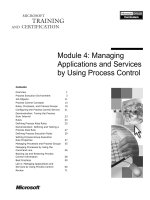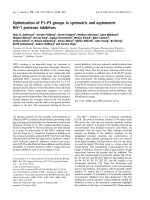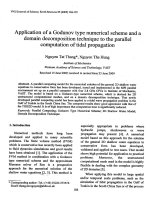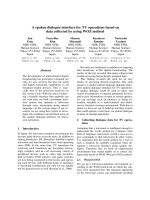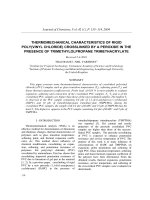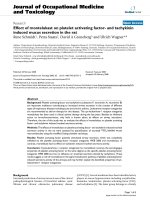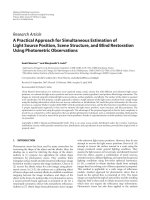Optimization of process parameters for friction Stir welding of dissimilar Aluminum alloys (AA2024 -T6 and AA6351-T6) by using Taguchi method
Bạn đang xem bản rút gọn của tài liệu. Xem và tải ngay bản đầy đủ của tài liệu tại đây (267.29 KB, 10 trang )
International Journal of Industrial Engineering Computations 4 (2013) 71-–80
Contents lists available at GrowingScience
International Journal of Industrial Engineering Computations
homepage: www.GrowingScience.com/ijiec
Optimization of process parameters for friction Stir welding of dissimilar Aluminum alloys
(AA2024 -T6 and AA6351-T6) by using Taguchi method
P. Murali Krishnaa*, N. Ramanaiahb and K. Prasada Raoc
a
Ph.D scholar, Andhra University, Mechanical Engg. Dept., Visakhapatnam, A.P, India
Associate Professor, Andhra University, Mechanical Engg. Dept., Visakhapatnam, A.P, India
IITM, Department of Metallurgical and Materials Engineering, Chennai, Tamil Nadu, India
b
c
CHRONICLE
ABSTRACT
Article history:
Received August 25 2012
Received in revised format
November 16 2012
Accepted November 16 2012
Available online
16 November 2012
Keywords:
Friction stir welding
Taguchi
Optimization
Process Parameters
The present study focused on the Taguchi experimental design technique of Friction Stir Welds
of dissimilar aluminum alloys (AA2024-T6 and AA6351-T6) for tensile properties. Effect of
process parameters, rotational speed, Traverse speed and axial force, on tensile strength was
evaluated. Optimized welding conditions for maximize tensile strength were estimated in order to
improve the productivity, weld quality. Non-linear regression mathematical model was developed
to correlate the process parameters to tensile strength. The results were verified by conducting the
confirmation tests at identified optimum conditions.
© 2013 Growing Science Ltd. All rights reserved
1. Introduction
Friction Stir Welding (FSW) was invented in 1991 at The Welding Institute (TWI) of UK, and initially
useful for the joining of aluminum alloys traditionally difficult to weld materials in which the fusion
welding techniques produce brittle dendritic structures producing a strong decrease in the mechanical
properties (Thomas et al., 1991). Significant interest has been shown in the use of advanced welding
techniques for aircraft structures, Process industry etc. Whilst a variety of welding methods have been
identified for airframe structures, friction stir welding is an important technique that is low energy
consumption solid-state process (Lee et al., 2003). Many scientists demonstrated the lower distortion
and low presence of residual stresses in FSW joints with respect to the traditional welding techniques
(Jata et al., 2000; Bussu & Irving, 2003; John et al., 2004). Defect free welds with good mechanical
properties have been made in a variety of aluminum alloys, even those previously thought to be not
having much weldability. There have been a lot of efforts to understand the effect of process
parameters on material flow behavior, microstructure formation and hence mechanical properties of
FSW joints. In order to study the effect of FSW process parameters, most workers follow the traditional
* Corresponding author.
E-mail: (P. Murali Krishna)
© 2013 Growing Science Ltd. All rights reserved.
doi: 10.5267/j.ijiec.2012.011.002
72
experimental techniques, i.e. varying one parameter at a time while keeping others constant. This
conventional parametric design of experiment approach is time consuming and calls for enormous
resources.
Taguchi method is a power full tool which can upgrade/improve the performance of the product,
process, design and system with a significant slash in experimental time and cost (Montgomery, 2006).
It appears that the optimization of FSW process parameters of dissimilar aluminum alloy (AA2024-T6
& AA6351-T6) using Taguchi method has not been reported yet. Considering the above fact, the
Taguchi method is adopted to analyze the effect of process parameters (i.e. rotational speed (RS),
traverse speed (TS) and axial force (AF)) for optimizing tensile strength of FS Welds of dissimilar
aluminum alloys (AA2024-T6 & AA6351-T6)
2. Taguchi method
The Taguchi Method is a multi-stage process, namely, systems design, parameter design, and tolerance
design. The Taguchi method is used to improve the quality of products and processes. Improved quality
results when a higher level of performance is consistently obtained. The highest possible performance
is obtained by determining the optimum combination of design factors. The consistency of performance
is obtained by making the product/process insensitive to the influence of the uncontrollable factor. In
Taguchi's approach, optimum design is determined by using design of experiment principles, and
consistency of performance is achieved by carrying out the trial conditions under the influence of the
noise factors (Ross, 1988).
Taguchi defines three categories of quality characteristics in the analysis of Signal/Noise ratio, i.e. the
lower-the-better, the larger-the-better and the nominal-the-better. The S/N ratio for each of process
parameter is computed based on S/N analysis. Regardless of the category of the quality characteristics,
a larger S/N ratio corresponds to better quality characteristics. Therefore, the optimal level of process
parameter is the level of highest S/N ratio. Furthermore, a statistical analysis of variance (ANOVA) has
been performed to see which process parameter is statistically significant for each quality
characteristics and its relative contribution on the total performance.
3. FSW Process parameters
The first step in the selection of process parameters is to conduct the brain storming session to select
the process parameters which play a major role in deciding the weld quality. In the present
investigation, three process parameters were selected for study. When the RS was lower than 800 rpm,
wormhole at the retreating side of weld nugget was observed and it may be due to insufficient heat
generation and insufficient metal transportation; when the RS was higher than 1600 rpm, tunnel defect
was observed and it might be due to excessive turbulence. Similarly, when the TS was lower than 0.35
mm/s, pin holes type of defect was observed due to excessive heat input per unit length of the weld and
no vertical movement of the metal. When TS was higher than 1.5mm/s, tunnel at the bottom in
retreating side was observed due to insufficient heat. Based on the trials and available literature, the
following range of process parameters were selected (Table 1)
Table 1
Process Parameters with their values at corresponding levels
S. No
Process Parameters
Range
1
Rotational Speed(RS)
800-1600rpm
2
Traverse Speed(TS)
0.35-1.5mm/s
3
Axial Force(AF)
1000-7000 N
Level
800
0.35
3000
Level 2
1200
0.7
5000
Level 3
1600
1.2
7000
73
P. Murali Krishna et al. / International Journal of Industrial Engineering Computations 4 (2013)
4. Materials and Methodology
The base materials selected for this investigation were AA6351-T6 and AA2024-T6 aluminum alloys
sheets of 5 mm thickness having chemical composition and mechanical properties shown in the Table 2
and 3. In the present study, sheets of size 200mm x 70mm of AA6351-T6 and AA2024-T6 were cut for
welding by FSW (Fig.1). The AA6351-T6 alloy sheet was located on the retreating side and AA2024T6 was placed on the advancing side. The rotating tool used in this study was made of high-speed tool
steel (Fig.2).
Fig.1. Experimental set up
Transverse tensile tests were performed in order to evaluate the tensile properties of the joints obtained
by FSW process of the two dissimilar materials. To determine the tensile strength of the stir zone (SZ),
tensile test specimens were sectioned as per ASTM-E8 (Fig.3) in the transverse direction perpendicular
to the weld line with an electrical discharge machine (EDM). Tensile test specimen as shown in the
Fig.4
Table 2
Chemical Composition of base materials AA2024-T6 and AA6351-T6
Material
Si
Fe
Cu
Mn
AA2024
0.118
0.209
3.99
0.53
AA6351
1.040
0.372
1.20
0.65
Table 3
Mechanical properties of base materials AA2024-T6 and AA6351-T6
Material
UTS
(%)
(Mpa)
Elongation
AA2024
496
10.54
AA6351
329
11.7
Mg
1.28
1.14
Al
Bal.
Bal.
Micro Vickers
Hardness(VHN) (0.1kgf)
122.2
98.34
74
Fig. 2 Geometry of the rotating tool
Fig. 3. Schematic view of the FS Welded Joint with the extraction of tensile specimens
Fig. 4. Tensile Test Specimen
5. Results and discussions
5.1 Signals to Noise Ratio
Tensile strength is one of the main characteristics considered in this investigation describing the quality
of FSW joints. Each control factor can be calculated in order to assess the influence of parameters on
the response, the means and signal-to-noise (S/N) ratios. The signals are indicators of the effect on
75
P. Murali Krishna et al. / International Journal of Industrial Engineering Computations 4 (2013)
average responses and the noises are measures of the influence on the deviations from the sensitiveness
of the experiment. The appropriate S/N ratio must be chosen using previous knowledge, expertise, and
understanding of the process. When the target is fixed and there is trivial or absent signal factor (static
design), it is possible to choose the signal-to-noise (S/N) ratio depending on the goal of the design
(Phadke, 1989). In this study, the S/N ratio was chosen according to the criterion of the larger the
better, in order to maximize the response. In Taguchi method, the signal to noise ratio is used to
determine the deviation of the quality characteristics from the desired value. The S/N ratio (larger-thebetter) can be expressed as
= −10 log
1
1
(1)
,
where n is the number of tests conducted, yi is the average observed data of each test. In the present
study, the tensile strength data were analyzed to determine the effect of FSW process parameters. The
experimental results were then transformed into means and signal-to-noise (S/N) ratio. In this work, 27
means and 27 S/N ratios were calculated and the estimated tensile strength, means and signal-to-noise
(S/N) ratio are given in Table 4.
Table 4
Mean and S/N ratio of tensile strength of FS Welds
S.no
1
2
3
4
5
6
7
8
9
10
11
12
13
14
15
16
17
18
19
20
21
22
23
23
25
26
27
Rotational
Speed(RS)
(rpm)
800
800
800
800
800
800
800
800
800
1200
1200
1200
1200
1200
1200
1200
1200
1200
1600
1600
1600
1600
1600
1600
1600
1600
1600
Traverse
Speed(TS)
(mm/s)
0.35
0.35
0.35
0.7
0.7
0.7
1.2
1.2
1.2
0.35
0.35
0.35
0.7
0.7
0.7
1.2
1.2
1.2
0.35
0.35
0.35
0.7
0.7
0.7
1.2
1.2
1.2
Axial
Force(AF)
(N)
3000
5000
7000
3000
5000
7000
3000
5000
7000
3000
5000
7000
3000
5000
7000
3000
5000
7000
3000
5000
7000
3000
5000
7000
3000
5000
7000
Mean UTS
(Mpa)
210
215
223
212
220.5
226
211
213.4
216
245
250
254
243
256
263
226
238
243
228
232.1
241
231
240
251
217
225
232
S/N Ratio
46.4444
46.6488
46.9661
46.5267
46.8682
47.0822
46.4856
46.5839
46.6891
47.7833
47.9588
48.0967
47.7121
48.1648
48.3991
47.0822
47.5315
47.7121
47.1587
47.3135
47.6403
47.2722
47.6042
47.9935
46.7292
47.0437
47.3098
The analysis of mean for each of the experiments will give the better combination of parameters levels
that ensures a high level of tensile strength according to the experimental set of data. The mean
response refers to the average value of performance characteristics for each parameter at different
levels. The mean for one level was calculated as the average of all responses that were obtained with
76
that level. The mean response of raw data and S/N ratio of tensile strength for each parameter at level 1,
2, and 3 were calculated and are given in Table 5. The means and S/N ratio of the various process
parameters when they changed from the lower to higher levels are also given in Table: 5. It is clear that
a larger S/N ratio corresponds to better quality characteristics. Therefore, the optimal level of process
parameter is the level of highest S/N ratio (Sharma et al., 2005). The mean and S/N ratio (Table 5.) for
tensile strength were calculated by statistical software, indicating that the tensile strength was at
maximum when rotational speed at 1200 rpm, traverse speed at 1.2 mm/s and axial force at 7000N. The
comparison of mean and S/N ratio are presented in Fig: 4
Table 5
Main effects of tensile strength (Means and S/N ratio)
Levels
Process Parameter
L1
L2
L3
Delta
RS
216.3
246.4
233.0
30.1
Means
TS
233.1
238.1
224.6
13.5
AF
224.8
232.2
238.8
14.0
RS
46.70
47.83
47.34
1.13
S/N Ratio
TS
47.33
47.51
47.02
0.50
AF
47.02
47.30
47.54
0.52
5.2 Analysis of variance (ANOVA)
Analysis of variance (ANOVA) test was performed to identify the process parameters that are
statistically significant. The purpose of the ANOVA test is to investigate the significance of the process
parameters which affect the tensile strength of FSW joints. The ANOVA results for tensile strength of
means and S/N ratio are given in Table 4. In addition, the F-test named after Fisher can also be used to
determine which process has a significant effect on tensile strength. Usually, the change of the process
parameter has a significant effect on the quality characteristics, when F is large (Table 6 and 7). The
results of ANOVA indicate that the considered process parameters are highly significant factors
affecting the tensile strength of FSW joints in the order of rotational speed, axial force and traverse
speed. Effects of interaction between process parameters are not significant.
Table 6
ANOVA of tensile strength (Means)
Means
Source
DF
Seq SS
Adj SS
Adj MS
F
P
% of contribution
RS
2
4098.97
4098.97
2049.48
149.67
0.000
67.31
TS
2
834.05
834.05
417.03
30.45
0.000
13.70
AF
2
883.19
883.19
441.59
32.25
0.000
14.50
Error
20
273.87
273.87
13.69
04.49
Total
26
6090.07
100
DF─Degrees of freedom, Seq SS─Sequencial sum of squares, Adj SS─Adjusted sum of square, Adj MS─Adjusted mean
square,F─Fisher ratio, P─probability that exceeds the 95 % confidence level.
Table 7
ANOVA of tensile strength (S/N Ratio)
S/N Ratio
Source
DF
Seq SS
Adj SS
Adj MS
F
P
% of contribution
RS
2
5.7547
5.7547
2.8773
172.36
0.000
68.13
TS
2
1.1312
1.1312
0.5656
33.88
0.000
13.40
AF
2
1.2265
1.2265
0.6133
36.74
0.000
14.52
Error
20
0.3339
0.3339
0.0167
03.95
Total
26
8.4463
DF─Degrees of freedom, Seq SS─Sequencial sum of squares, Adj SS─Adjusted sum of square, Adj MS─Adjusted mean
square,F─Fisher ratio, P─probability that exceeds the 95 % confidence level.
77
P. Murali Krishna et al. / International Journal of Industrial Engineering Computations 4 (2013)
5.3 Optimizing the Tensile strength Properties
Analyzing means and S/N ratio of various process parameters (table3), it is observed that a larger S/N
ratio corresponds to better quality characteristics. Therefore, optimal level of process parameter is the
level of highest S/N ratio (Sharma et al., 2005). Mean and S/N ratio for ultimate TS was at maximum
when
1. Rotational speed (level 2) of 1200 rpm,
2. Traverse speed (level 2) of 1.2mm/s
3. Axial force (level 3) of 7000N
50
270
270
Means
260
50
260
Me ans
S/N Ratio
49
S/N Ratio
49
48
230
240
48
230
S/N Ratio
240
Tensile strength,Mpa
250
S/N Ratio
Tensile Strength, Mpa
250
220
220
47
47
210
210
200
200
46
800
1200
46
0.35
1600
0.7
1.2
Traverse Spe e d, mm/s
Rotational Spe e d
270
50
260
49
"Means"
"S/N Ratio"
240
48
230
S/N Ratio
Tensile strength ,Mpa
250
220
47
210
200
46
3000
5000
7000
Axial Force ,N
Fig.5. Response graphs of Means and S/N ratio of tensile strength
5.4 Estimation of optimum performance characteristics
Optimum value of UTS was predicted at selected levels of significant parameters. Significant process
parameters and their optimum levels have already been selected as rotational speed (level 2)of 1200
rpm and traverse speed(level 2) of 1.2mm/s and axial force( level 3) 7000N (Table 4 ).Estimated mean
of response characteristics (.UTS) can be calculated as
Ultimate tensile strength (UTS) =Average UTS (AUTS) + (RS2-AUTS) + (TS2-AUTS) + (AF3-AUTS)
=231.9+ (246.4-231.9) +238.1-231.9) + (238.8-231.9) =259.5 Mpa,
78
where UTS overall mean of ultimate tensile strength,RS2 average tensile strength of rotational speed at
level 2, TS2 average tensile strength of traverse speed at level 2, AF3 average tensile strength of axial
force at level 3.
5.5 Conformation testing
Conformation experiments were conducted at optimum setting of process parameters. rotational speed
(level 2)of 1200 rpm and traverse speed(level 2) of 1.2mm/s and axial force( level 3) 7000 N were set
and average UTS was found to be 262 Mpa, which was within confidence intervals of predicted
optimal UTS. The microstructure of traverse section of FS welded joint at optimum parameters reveals
that there was no defect due to sufficient heat generation and also it was found that the fine grain
structure caused for strength.
Fig. 6. Optical microstructure of SZ at optimized condition
5.6 Development of the mathematical model ( Non-linear regression model )
The ultimate Tensile strength is the function of Rotational speed ,Traverse speed and axial force and it
can be expressed as
Y= f (RS, TS, AF),
(2)
where Y is the response known as UTS.
For the three factors, the selected regression polynomial could be as
Y= b0 +b1RS+b2TS +b3AF +b12RS*TS+b23TS*AF+b31AF*RS + b11RS2+b22TS2+b33AF2 ,
(3)
where b0 is a constant, b1, b2, b3 are linear terms, b11, b22, b33 quadratic terms and b12, b23, b31 are
interaction terms. To correlate the process parameters UTS values, a non-linear regression model was
developed to predict the UTS of FS Welds of AA 2024-T6 and AA 6351-T6 aluminum alloys.
Regression coefficients were calculated by using statistical software MINI TAB 15.0. After
determining the coefficients, final model was developed with these coefficients to determine UTS,
UTS = -9.1+0.347*RS+77*TS+0.00251*AF-0.0111*RS*TS+0.0001*TS*AF+0.000001*RA*AF
- 0.000135*RS2 -47.7*TS2-0.0*AF2
(4)
The model was tested by using ANOVA .All terms including RS, TS, AF, RS2, TS2, were found to be
significant at 95% confidence interval. The goodness of the fit of the model was verified by knowing
the R2 (96.5) values. The value of adjusted R2 (94.6) is also high, which indicates a high significant of
the model. Besides, the diagnostic checking has been performed through residual analysis. The
79
P. Murali Krishna et al. / International Journal of Industrial Engineering Computations 4 (2013)
residual plots for tensile strength are shown in Fig. 7 and 8. These were fall on the straight line
implying that errors were distributed normally. Almost, the values are within the confidence level 95%.
Hence, these values yielded better results in future prediction.
Normal Probability Plot
Residuals Versus Fits
(response is Tensile Strength)
(response is Tensile strength)
99
10.0
95
7.5
90
5.0
70
Residual
Percent
80
60
50
40
30
20
0.0
-2.5
10
5
1
2.5
-5.0
-10
-5
0
Residual
5
Fig. 7. Normal probability of the residuals for Tensile
strength
10
200
210
220
230
Fitted Value
240
250
260
Fig. 8. Residuals versus fitted values for Tensile strength
6. Conclusions
The following conclusions have been derived by applying ANOVA on the experimental investigations
of AA 6351-T6 and AA 2024-T6 alloys by FSW.
•
•
•
The optimum value of process parameters such as rotational speed, traverse speed and axial
force are found to be 1200rpm( level 2), 1.2 mm/s(level 2) and 7000N ( level 3) respectively
The optimum parameters were evaluated and the percentage of contribution of FSW process
parameters was evaluated. It was found that the tool rotational speed had 67.31% contribution,
traverse speed had 13.7% contribution and axial force had 14.5% contribution in yield of
welded joints.
The predicted tensile strength by the model is fairly accurate and it was also concluded with the
analysis of residual plots which did not indicate any model inadequacy.
Acknowledgements
The authors are grateful to the Department of Metallurgical and Materials Engineering, IITM, Chennai,
Tamil Nadu, India for extending the facilities of Metal Joining Laboratory to carry out the experiments.
The authors also wish to express their sincere thanks to Mechanical Engineering Department, Osmania
University to carry out the investigations
References
Thomas, W. M., Nicholas, E. D., Needam, J. C., Murch, M. G., Templesmith, P. & Dawes, C. J (1991).
GB Patent Application No. 9125978.8, December 1991 and US Patent No. 5460317, October 1995.
Lee, W.-B., Yeon, Y.-M., & Jung, S.-B. (2003). The Joint Properties of Dissimilar Formed Al Alloys
by Friction Stir Welding According to the Fixed Location of Materials. Scripta Materialia, 49, 423–
428.
Bussu, G., & Irving, P. E. (2003). The Role of Residual Stress and Heat Affected Zone Properties on
Fatigue Crack Propagation in Friction Stir Welded 2024-T351 Aluminium Joints. International
Journal of Fatigue, 25, 77–88.
80
John, R., Jata, K.V., & Sadananda, K. (2003). Residual Stress Effects on near Threshold Fatigue Crack
Growth in Friction Stir Welded Aerospace Alloys. International Journal of Fatigue, 25, 939–948.
Jata, K. V., Sankaran, K. K., & Ruschau, J. (2000). Friction-Stir Welding Effects on Microstructure and
Fatigue of Aluminum Alloy 7050-T7451. Metallurgical and Materials Transactions, 31A, 2181–
2192.
Montgomery, D. C. (2006). Design and analysis of experiments, IV Edition. NY: John-Wiley & Sons,
Inc.,
Ross, P. J. (1988). Taguchi techniques for quality engineering. NY: Tata McGraw Hill,
Phadke, M. S. (1989). Quality engineering using robust design. NJ, USA: PTR, Prentice Hall,
Englewood Cliffs,
Sharma, P., Verma, A., Sidhu, R.K., & Pandey, O.P. (2005). Process parameter selection for
strontium ferrite sintered magnets using Taguchi L9 orthogonal design. Journal Material Processing
Technology, 168, 147−151.
MINITAB Statistical software Release 15.0.
